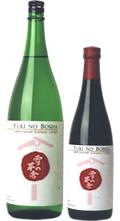 Sheesh. I think I am about to turn into a rice grain or better yet, I might be turning Japanese (I really think so). Lately, chiefwino has been tasting, tasting, tasting---not wine, but lots of Sake.
Sheesh. I think I am about to turn into a rice grain or better yet, I might be turning Japanese (I really think so). Lately, chiefwino has been tasting, tasting, tasting---not wine, but lots of Sake.You all know Sake. The traditional Japanese 'wine' that some love to hate. I will admit, I was not a fan. There is just something about the aroma and flavor that I did not dig. It could be that often overwhelming moldy aroma found on the nose or maybe the bitter finish from a swig of cheap hot sake at a mediocre sushi joint.
Whatever the case, I am now a convert. Credit my recent restaurant sake list projects I have undertaken and a few vendors hawking incredible, artisanal sakes.
It also doesn't hurt that most of the tastings took place with a large plate of sushi on the side.
Sake is made via an intense brewing process using rice, yeast, mold and lots of spring water. In fact, the final product is roughly 80% water. Basically the rice is washed, steam cooked and then mixed with yeast and koji. Koji is a special mold spore which when cultivated on the rice releases enzymes which break down starch into sugars that can be fermented by yeast into alcohol (no wonder I encounter moldy aromas on Sake!) After fermentation is complete, the liquid is pressed, filtered, blended and pasteurized.
One thing to note is the various grades of sake. Before the rice is washed and steamed, a certain amount of the outer husk is polished away. The amount of polishing greatly influences the flavor of the final product.
 A few terms to note:
A few terms to note:Junmai/Honjozo--The lowest level of premium sake. At least 30% of the outer husk polished away. Honjozo refers to Sake with additional distilled alcohol added. If the word Junmai appears on a label, it means only rice alcohol.
Ginjo--At least 40% of the rice grain polished away. More complex flavors and often fruity and floral.
Dai-ginjo--At least 50% of the rice grain polished away. This is ultra-premium sake and often very expensive. These are often heavier and fuller than the other styles. I tend to note a black licorice aroma on some of the dai-ginjo sake I have sampled.
Nigori--these are unfiltered sakes often with small rice chunks.
Now with that basic understanding of the sake production process and a little vocabulary, you should be ready to go out and find something that suits your personal taste. Oh and regarding the question of hot or cold: most premium sake should be served slightly chilled...say around 50-60 degrees. Like wine, sake served too cold will not release aromatics. Sake served warm is generally lower quality.
Here are a few favorites from my recent tastings:
 Hakushika Chokara 'Extra Dry'’ Junmai,
Hakushika Chokara 'Extra Dry'’ Junmai,Hyogo Prefecture, Japan
Refreshing and clean, hint of grapefruit, well-balanced
Kiku-Masamune Taru-Sake Junmai,
Hyogo Prefecture, Japan
Rich, smooth, hint of green apple, slight cigar box aromas, aged in Yoshino cedar
Kasumi Tsuru Kimoto Extra Dry,
Hyogo Prefecture, Japan
Light, lively citrus notes, a bit creamy, clean, dry
Ichishima '‘Karen Coy'’ Junmai
Niigata Prefecture, Japan
Fragrant, lychee, apple and strawberry notes, clean, crisp, slightly sweet
Yuki No Bosha 'Cabin in the Snow' Junmai-ginjo,
Akita Prefecture, Japan
Soft, notes of strawberry, peach, a hint of licorice,
crisp, clean, dry
Minogawa Koshi No Omachi Dai-ginjo,
Niigata Prefecture, Japan
Super-premium sake with intense aromas of spice, black licorice, clean, dry, made from Omachi rice, one of the best rice for sake
 Rihaku Shuzo 'Dreamy Clouds'
Rihaku Shuzo 'Dreamy Clouds'Tokubetsu Junmai Nigori,
Shimanae Prefecture, Japan
Creamy, complex, prune and nut aromas, unfiltered
Poochi-Poochi Naturally Sparkling Nigori,
Fukushima Prefecture, Japan
Light, smooth, sweet fruit aromas, slightly unfiltered, naturally effervescent. This one is extremely fun to drink...so fun, you might drink an entire bottle and not notice.
Bottle images from www.ratebeer.com
1 comment:
I quoted your Karen Coy tasting notes on my blog today. Agree with all the fruits you tasted and the fragrance, but I definitely found it more than slightly sweet!
Post a Comment